Kajian
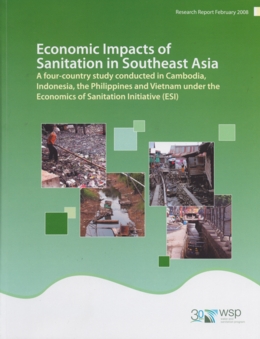
Economic Impacts of Sanitation in Southeast Asia: A four-country study conducted in Cambodia, Indonesia, The Philippines and Vietnam under the Economics of Sanitation Initiatives (ESI)
Th.
1.048
This study examines the major health, water, environmental, tourism and other welfare impacts associated with poor sanitation in Cambodia, Indonesia, The Philippines and Vietnam. The study is based on evidence from other investigations, surveys and databases. The impact measurement reported in the study focuses mainly on a narrow definition of sanitation – human excreta management and related hygiene practices. The measurement of water resource impact also includes grey water, and the measurement of environmental impact includes solid waste management. By examining the economic impacts of poor sanitation, and the potential gains from improved sanitation, this study provides important evidence to support further investment in sanitation. The goal of this report is to show decision-makers at the country and regional levels how the negative impacts of poor sanitation can be mitigated by investing in improved sanitation. Table of Contents: Executive Summary Foreword Abbreviations and Acronyms Acknowledgement Table of Contents 1. Introduction 2. Study Methodology Overview 3. Economic Impact Results 4. Discussion, Recommendations and Conclusions Annexes Annex A: Study Methods Annex B: Algorithms Annex C: Study Results Annex D: References

Konservasi dan Perkembangan Ekonomi: Studi Kasus Kota Liverpool dan Kota Chester-Inggris
Ari Widyanti Purwantiasning, John Christian Stonard, & Mark Terrence J. Thorne
Th.
1.838
Proyek pelestarian kota-kota tua dan bersejarah telah dimulai sejak awal 1966 yang bertujuan untuk mempelajari, menemukan serta menganalisa masalah-masalah yang timbul saat ini, berkaitan dengan perkembangan masa mendatang, kemudian mengaitkannya dengan konservasi jangka panjang serta perbaikan karakter serta lingkungan dari kota-kota tua dan bersejarah di Inggris. Pada dasarnya masalah-masalah tersebut terlihat di semua kota di Inggris baik kota bersejarah maupun bukan, tetapi dapat dirasakan bahwa masalah yang paling inti dimana akan menjadi hal signifikan adalah nilai-nilai sejarah yang harus tetap menjadi fokus utama. Tulisan ini merupakan laporan penelitian yang dijabarkan dari hasil presentasi konferensi pada tanggal 18 Desember 1998. Penelitian mendiskusikan mengenai perkembangan ekonomi dan komersial sebagai dampak dari adanya konsep konservasi. Hal ini dimaksudkan untuk mengukur seberapa jauh isu-isu dari kualitas konsep konservasi di dalam suatu daerah atau area konservasi. Pada tulisan ini akan dipaparkan dua buah studi kasus yang menjadi fokus dalam penelitian yaitu Kota Chester dan Kota Liverpool dimana keduanya mempunyai karakter yang berbeda yang tentunya berdampak pada kualitas penampilan yang berbeda pula. Daftar isi: Daftar Isi Pengantar Kesatu: Pendahuluan Kedua: Acuan Teori Ketiga: Studi Kasus Chester Keempat: Studi Kasus Liverpool Kelima: Kesimpulan Appendiks Daftar Pustaka Tentang Penulis
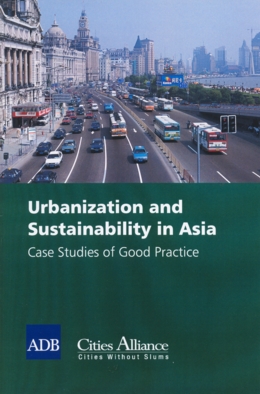
Urbanization and Sustainability in Asia: Case Studies of Good Practices
Brian Roberts and Trevor Kanaley (Ed)
Th.
1.047
The book presents case studies of good practice on sustainable urban development from 12 Asian countries: Bangladesh, Cambodia, People's Republic of China, India, Indonesia, Lao People's Democratic Republic, Malaysia, Pakistan, Philippines, Sri Lanka, Thailand, and Viet Nam. It provides insights into current issues, management approach, and investment types in urban development in Asian setting. It also provides other examples of good practice in sustainable urban development in the context of more advanced economies. It is a useful reference for city managers, political leaders, and professionals responsible for planning and managing the development of cities.
Daftar isi:
Overview
Urbanization and Sustainability in Asia
Bangladesh
Cambodia
People's Republic of China
India
Indonesia
Lao People's Democratic Republic
Malaysia
Pakistan
Philippines
Sri Lanka
Thailand
Viet nam
Global Good Practices
Lessons and Strategies for Sustainable Urban Futures

Community-driven Development for Water and Sanitation in Urban Areas: Its contribution to meeting the Millenium Development Goal targets
David Satterthwaite with Gordon McGranahan and Diana Mitlin
Th.
1.080
CONTENTS:
Summary
I. Introduction
II. The Scale of nedd in urban areas
III. Focusing action where needs are greatest
IV. Community-driven improvements in proven
V. Alternative means to support improvements in provision for water and sanitation
VI. Financing water and sanitation improvements through loans and subsidies
VII. Engaging with small-scale private water and sanitation providers
VIII. Reform within existing public and private utilities; examples from Bangalore and Buenos Aires
IX. Going to scale
X. The tools and methods that support community-driven improvements for water and sanitation
XI. Changing the donor-community interface
XII. Conclusions
Figures
Boxes
Annexes
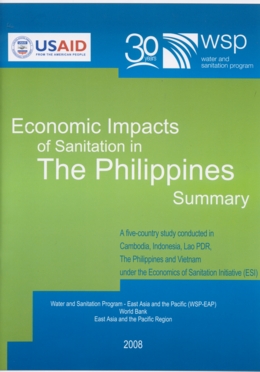
Economic Impacts of Sanitation in The Philippines Summary: A five-country study conducted in Cambodia, Indonesia, Lao PDR, The Philippines and Vietnam under the Economics of Sanitation Initiatives (ESI)
Th.
1.297
About 20 million Filipinos, or more than a quarter of the Philippine population,
were exposed to poor sanitation in 2004. Moreover, with an average population
growth of more than 2% per annum, an additional 2 million people will require
adequate and clean sanitation facilities each year. These facts raise serious
concerns because poor sanitation has a wide variety of negative impacts.
Sanitation is often a neglected aspect of development in developing
countries. This in part explains the lack of reliable data and research to
verify the significant burden imposed by poor sanitation on society. This
study attempts to address these shortcomings by conducting a quantitative
and qualitative assessment of the impacts of poor sanitation on health,
water, other welfare indicators, and tourism.
The analysis interpreted sanitation as activities that are related to human
excreta. However, there were instances in which sanitation as it relates
to gray water and solid waste were also included. The study relied on
evidence from secondary sources and was hence limited in the scope
of impacts examined.
Overall, the study estimates that poor sanitation leads to economic costs in the
order of US$1.4 billion or PhP 77.8 billion per year. This is equivalent to about
1.5% of GDP in 2005 and translates into per capita losses of US$16.8 or PhP
923.7 per year.
The health impacts represent the largest source of quantified economic costs.
Estimated to be about US$1 billion, this item explains about 71% of the total.
Poor sanitation also contributes to the pollution of water resources. The study
found that this aspect accounted for about 23% of the total economic costs or
US$323 million. Other welfare impacts and the impacts of poor sanitation on
tourism were also estimated to exceed US$77 million per year.
6 5
Having estimated the impacts, the study also evaluated the benefits
associated with improved sanitation and hygiene practices. The results
showed that improved hygiene practices•'3fe.g., hand washing•'3fcan
reduce health costs by approximately US$455 million. Improved
physical access to sanitary toilets can reduce economic costs associated
with user preferences by about US$38 million, whereas improved
toilet systems can reduce health costs by US$324 million. Improvement
in the treatment or disposal of waste has a large impact on water
resources and can reduce costs by US$364 million.
The findings of this study indicate that poor sanitation has significant
economic costs. It also showed that improvements in the sanitation
sector will not only result in economic savings but will also lead to
gains that go beyond the simple mitigation of the costs, such as the
value of human excreta used for fertilizer.
This is the first regional study to compile economic evidence on a
range of impacts of poor sanitation. The results are a wake-up call to
the Philippine government and the development community. Poor
sanitation affects everyone, especially the poor and vulnerable (children,
women, disabled, and senior people). The considerable importance
of sanitation shown in this study and the key links improved sanitation
has with other development goals (poverty and hunger reduction,
gender equality, child health, access to safe drinking water, and quality
of life of slum dwellers) demonstrate that it should receive far greater
attention from players whose interest is the equitable socioeconomic
development of the
in a concerted way to increase access to improved sanitation and
hygiene practices.
Daftar Isi:
Acknowledgments
Executive Summary
1. Introduction
2. Methods
2.1 Study Approach
2.2 Scope of ’Sanitation’
2.3 Impacts Evaluated
2.4 Impact Mitigation
3. Results
3.1 Summary of Economic Impacts of Poor Sanitation
3.2 Health Impacts
3.3 Water Resource Impacts
3.4 Other Welfare Impacts
3.5 Tourism Impact
3.6 Economic Gains from Improved Sanitation and Hygiene
3.7 Omitted Impacts
4. Recommendations
Annex
Abbreviations
Tables
Figures
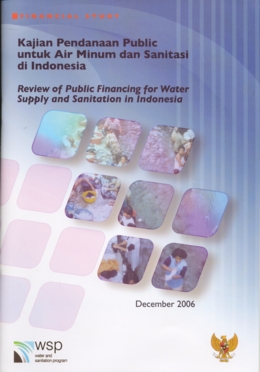
Kajian Pendanaan Public untuk Air Minum dan Sanitasi di Indonesia/ Review of Public Financing for Water Supply and Sanitation in Indonesia (Financial Study)
Th.
1.102
Studi ini memberikan gambaran besaran dan kualitas investasi yang telah dilakukan pada sektor AMPL di era desentralisasi sebagai sarana memahami permasalahan-permasalahan mendasar terkait dengan kesenjangan dalam pendanaan sektor. Laporan studi ini dipaparkan dalam bahasa Inggris.
Daftar isi:
Abbreviation and Acronyms
Information and Acknowledgment
Table of Contents
Report Summary In Indonesia
1.Introduction
1.1Objective of the Study
1.2Study Scope, Method and Limitations
2.Sector Background
2.1 Position at Decentralization
2.2 Position Post-Decentralization
3.Institutional Context
3.1 National Level
3.2 Local Level
4.National Water Supply and Sanitation Strategies
5.Financial Policies
5.1 Public Financing for Water Supply and Sanitation
5.2 Public Financial Planning and Budgeting Policies
6.Budget Trends for Water Supply and Environmental Sanitation (WSES) 2003-2005
6.1Local Investment in Water Supply and Environmental Sanitation
6.2National Investment in Water Supply and Environmental Sanitation
6.3National and Local Government Support to PDAMs
7.Conclusions
8.Next Steps on Finance Strategy
Annexes
Annex 1
Annex 2
Annex 3
Appendices
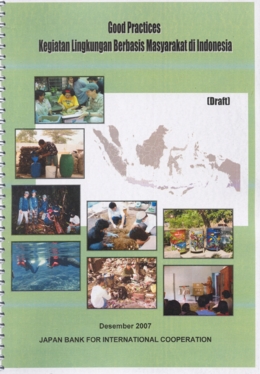
Good Practices Kegiatan Lingkungan Berbasis Masyarakat di Indonesia (Draft)
Th.
1.108
Pustaka ini memperkenalkan 21 good practices dalam kegiatan lingkungan berbasis masyarakat di Indonesia. Pustaka ini disusun sebagai sarana untuk berbagi pengetahuan dan pengalaman dalam kegiatan lingkungan berbasis masyarakat, untuk para pakar yang terlibat dalam pendidikan lingkungan dari lembaga-lembaga terkait, termasuk instansi pemerintah pusat dan daerah, LSM, perusahaan swasta dan lembaga donor, agar nantinya kegiatan lingkungan menjadi semakin baik.
Kegiatan lingkungan yang disebutkan dalam pustaka ini meliputi konservasi hutan, konservasi air dan tanah, konservasi ekosistem, dan pengelolaan sampah dengan 3R.
Daftar isi:
I. Pengelolaan Sampah dengan 3R
1. Pengelolaan Sampah Terpadu di Banjarsari, Cilandak, Jakarta Selatan
2. Pengelolaan Sampah Terpadu di Perumahan Mustika Tigaraksa, Tangerang
3. Desentralisasi Pengelolaan Sampah di Bukit Kencana Jaya, Semarang
4. Pengelolaan Sampah Terpadu di Surabaya (Menggunakan Metode Home Methode Takakura)
5. Pengelolaan Kompos di Kebun Karinda, Lebak Bulus, Jakarta Selatan
6. Pengelolaan Sampah Terpadu di Pondok Pekayon Indah, Bekasi Selatan
7. Pengelolaan Sampah Terpadu di Kampung Sukunan, Sleman, Yogyakarta
8. Mengubah Sampah menjadi Peluang Bisnis
9. Manajemen Kompos “Mutu Elok” di Perumahan Cipinang Elok Settlement, Jakarta Timur
10. Pengelolaan Kompos Cair di Cempaka Baru, Jakarta Pusat
11. Pengelolaan Sampah Terpadu di Kampung Rawajati, Pancoran
12. Pengelolaan Kompos di Kampung Cibangkong, Bandung, Jawa Barat
13. Pengelolaan Sampah Terpadu di Kampung Rawasari, Cempaka Baru, Jakarta Pusat
14. Program Daur Ulang Kemasan Kertas Tetra Pak
15. Pengelolaan Sampah Terpadu di SMA 34, Lebak Bulus, Jakarta
II. Forest Conservation
1. Pemberdayaan Masyarakat di Suaka Margasatwa di Gunung Simpang, Cianjur melalui Pemberlakuan Peraturan Desa dan Pembentukan Kelompok Penjaga Hutan bernama “Raksabumi”
2. Gerakan Desa Lingkungan, Perluasan Wilayah Kelola Rakyat (Sistem Hutan Kerakyatan)
III. Ecosystem Conservation
1. Klub Konservasi Sekolah (KKS)
2. Program Pelatihan Ekosistem untuk Siswa SMUN 69
IV. Water and Soil Conservation
1. Pendidikan Ekologi, Pendidikan Lingkungan Berbasis Alam untuk Siswa SD dan SMP di sepanjang Sungai Citarum
2. Pendidikan Lingkungan Terkait dengan Air dan Tanah
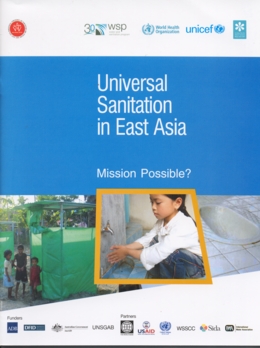
Universal Sanitation in East Asia: Mission Possible?
Andy Robinson
Th.
1.045
Summary
800 Million People in East Asia lack Adequate Sanitation
Dirty Realities
Sanitation is Vital for Human Health
Sanitation is Good for Economic Growth and Poverty Reduction
Sanitation Contributes to Social Development
Sanitation Helps the Environment
Sanitation Affects Children's Development and Our Future
Hygiene-don't Forget to wash Your Hands with Soap!
The Scale of the Sanitation Challenge
Progress Report: Updated Sanitation Coverage Estimates
Progress Report: National Sanitation Achievements
Three-quarters of those without Sanitation live in Rural Areas
Are the Poor being left behind
Financing Sanitation
What should be done in East Asia
Striving for Universal Sanitation
References
Annex 1: Sanitation Coverage Estimates
Annex 2: Diarrheal Disease Data
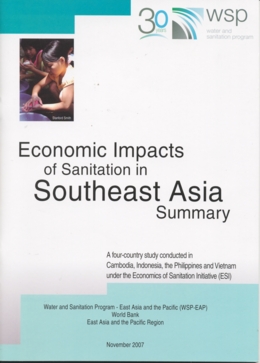
Economic Impacts of Sanitation in Southeast Asia Summary: A four-country study conducted in Cambodia, Indonesia, the Philippines and Vietnam under the Economics of Sanitation Initiatives (ESI)
Th.
1.256
The Sanitation Impact Study was conducted in
This study examines the major health, water, environmental, tourism and other welfare impacts associated with poor sanitation in
of poor sanitation can be mitigated by investing in improved sanitation.
The study is based on evidence from other investigations, surveys and databases. The impact measurement reported in the study focuses mainly on a narrow definition of sanitation - human excreta management and related hygiene practices. The measurement of water resource impact included release of gray water to water bodies, and the measurement of environmental impact included poor solid waste management.
ecological sanitation approaches (fertilizer and biogas) would be worth an estimated US$270 million annually.
Daftar Isi:
Acknowledgments
Executive Summary
1. Introduction
2. Methods
2.1 Study Approach
2.2 Scope of ’Sanitation’
2.3 Impacts Evaluated
2.4 Impact Mitigation
3. Results
3.1 Health Impacts
3.2 Water Impacts
3.3 Environmental Impacts
3.4 Other Welfare Impacts
3.5 Tourism Impact
3.6 Overall Economic Impacts
4. Recommendations
Annex
Abbreviations
Tables
Figures
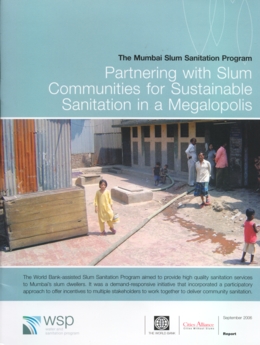
The Mumbai Slum Sanitation Program: Partnering with Slum Communities for Sustainable Sanitation in a Megalopolis
Shyamal Sarkar, Soma Ghosh Moulik, Somnath Sen
Th.
1.087
Preface
Background
Environmental Services in Mumbai Slums
Introducing a New Approach: The Slum Sanitation Program
Achievements of the Slum Sanitation Program
What Do We Learn from Mumbai
Appendix:
Slum Studied
Select References
